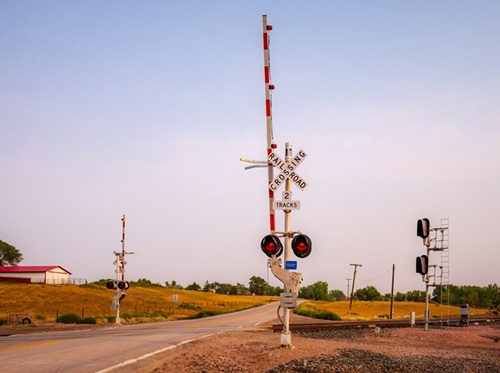The American Association of State Highway and Transportation Officials recently shared feedback with the Federal Motor Carrier Safety Administration regarding its recent notice of proposed rulemaking or NPRM that would broaden an exemption for certain commercial motor vehicles or CMVs to stop at all railroad grade crossings.
[Above photo via the USDOT]
Currently, drivers of passenger buses and CMVs transporting certain hazardous materials are required to stop before crossing a railroad track unless an exception applies, such as when the crossing is controlled by a functioning highway traffic signal transmitting a green indication.
FMCSA’s NPRM seeks to add a similar exception for a railroad grade crossing equipped with an “active” warning device, such as gates or flashing lights, that is not in an “activated state.”

That means if the crossing gates are not down and the flashing lights not activated to warn of an approaching train, those CMVs would be allowed to cross the railroad grade without stopping. Current regulations require passenger buses and trucks carrying specified hazardous materials to stop at grade crossings unless certain specified exceptions apply.
In its comment letter, AASHTO said that FMCSA’s proposed rule “requires additional consideration, particularly regarding increased efforts to examine relevant data to better inform the decisions on the proposed changes.”
The organization noted that, while states have varying opinions on the proposed changes that must be considered, at a minimum, any proposed change must be based on “sound data and have clear directions” to ensure the safety of the motoring public.
“The NPRM raises some concerns for state departments of transportation related to how the proposed change could disrupt the current safety regulatory landscape,” AASHTO said.
“Of particular concern is language in the NPRM indicating that FMCSA does not possess data on the number of stops that the proposed rule would eliminate because it cannot be estimated, as well as the assertion that there is no data on grade crossing encounters for the kinds of vehicles contemplated in the NPRM,” the organization said in its letter.
“AASHTO also notes that the NPRM states that cost estimates on savings that could result from this rulemaking cannot be developed because FMCSA asserts that there is no data on the number of grade crossing encounters for CMVs and passenger buses carrying hazardous materials,” it added.
AASHTO emphasized that states possess relevant data regarding the railroad grade crossings in their jurisdictions and would be happy to collaborate with FMCSA on this aspect of the NPRM.
“Further, on the roadway safety issues that FMCSA raised in the NPRM, AASHTO welcomes the opportunity to partner with FMCSA through our existing safety initiatives to promote better driver habits to help address the concerns about rear-end collisions with stopped vehicles at railroad grade crossings,” the organization said.
 Top Stories
Top Stories
Modal Administrators Speak at AASHTO Annual Meeting
December 5, 2025 Top Stories
Top Stories

